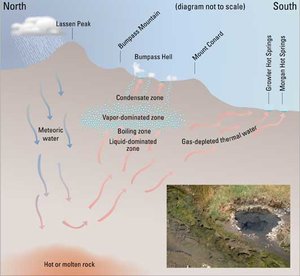Geothermal areas in Lassen Volcanic National Park
|
|
Geothermal_areas_in_Lassen_area.png
As in many hydrothermally active areas, the rocks at Sulphur Works and Little Hot Springs Valley in Lassen Volcanic National Park have been chemically altered into bright-colored clays. Sulfurous acid and sulfuric acid have broken down hard, gray-green andesite lavas into red, yellow and buff clays and iron oxides.
Missing image Bumpass_Hell_in_Lassen_VNP-1200px.JPG Bumpass Hell Missing image Sulpher_Works_in_Lassen_VNP-750px.JPG Sulpher Works |
Near Little Hot Springs Valley is Bumpass Hell, which is a hydrothermally altered geothermal area that spans 16 acres (65,000 m²) and has hot springs, fumeroles, and mud pots. Never part of Mount Tehema's main vent, Bumpass Hell is the result of fissures that tap the volcanic heat (which is thought to be a cooling mass of andesite, perhaps three miles (5 km) below the surface).
It is named after Kendall Vanbook Bumpass, a cowboy who worked in the Lassen area in the 1860s. One day Bumpass stumbled upon the area and his leg was badly scalded when it broke though a thin crust above a mud pot. He told his friends and townspeople about it, describing it as "hell." A newspaper editor was interested in the story and convinced Bumpass to take him to this place. Unfortunately, Bumpass' leg broke through the crust again - this time it had to be amputated.
About seven miles (11 km) southeast of Lassen Peak is Devils Kitchen. In this geothermal area the hot springs are so acidic that they have eaten pits and holes in the bedrock.
Reference
- Geology of National Parks: Fifth Edition, Ann G. Harris, Esther Tuttle, Sherwood D., Tuttle (Iowa, Kendall/Hunt Publishing; 1997) ISBN 0-7872-5353-7

